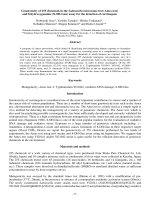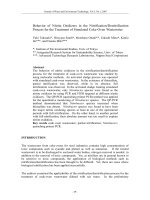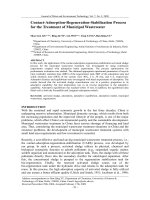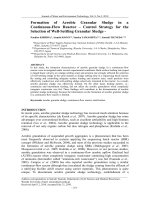Designation: C 514 – 96 - Nails for the Application of Gypsum Board1 pdf
Bạn đang xem bản rút gọn của tài liệu. Xem và tải ngay bản đầy đủ của tài liệu tại đây (16.83 KB, 2 trang )
Designation: C 514 – 96
Standard Specification for
Nails for the Application of Gypsum Board
1
This standard is issued under the fixed designation C 514; the number immediately following the designation indicates the year of
original adoption or, in the case of revision, the year of last revision. A number in parentheses indicates the year of last reapproval. A
superscript epsilon (e) indicates an editorial change since the last revision or reapproval.
This standard has been approved for use by agencies of the Department of Defense.
1. Scope *
1.1 This specification covers requirements for steel wire
nails suitable for use in the application of gypsum board.
NOTE 1—This specification does not necessarily cover nails for use
where fire ratings are required. Consult manufacturers for independent
data on assembly particulars, materials, and ratings.
1.2 The values stated in inch-pound units are to be regarded
as the standard.
1.3 The following precautionary caveat pertains only to the
test method portion, Sections 7 and 8, of this specification: This
standard does not purport to address all of the safety concerns,
if any, associated with its use. It is the responsibility of the user
of this standard to establish appropriate safety and health
practices and determine the applicability of regulatory limita-
tions prior to use.
2. Referenced Documents
2.1 ASTM Standards:
E 4 Practices for Force Verification of Testing Machines
2
3. Materials
3.1 Steel Wire, used in the manufacture of nails, shall be of
hard-drawn low or medium-low-carbon steel, entirely suitable
for the purpose intended. Before fabrication it shall be suffi-
ciently ductile to withstand cold-bending, without fracture,
through 180° over a radius not greater than the diameter of the
wire (see Section 8).
4. Physical Properties
4.1 Ductility—The nail shall be sufficiently ductile to with-
stand cold bending without fracture when tested according to
Section 8.
4.2 Withdrawal Resistance—The average withdrawal resis-
tance, both immediate and delayed, shall be at least equal to
that provided by 12.5 gage (0.099 6 0.003 in.) (2.515 6 0.08
mm) bright, smooth shank, nails with a medium diamond
point, when tested according to 8.2.
5. Dimensions and Permissible Variations
5.1 Heads—Shall be not less than 0.2375 in. (6.0 mm) and
not more than 0.3875 in. (9.8 mm) in diameter, shall be not
more than
1
⁄
64
in. (0.4 mm) thick at the peripheral edge, shall be
uniformly tapered to a small fillet around the shank, shall be
either flat or concave, and shall be free from protrusions and
sharp, irregular edges.
5.2 Shanks—Diameter shall not vary more than 6 0.003 in.
(0.08 mm) for shank diameters 0.076 in. (1.93 mm) or larger.
5.3 Points—The nails shall have medium to long diamond
or needle points.
5.4 Clearance—Where a deformation process produces
other than a smooth shank nail, a clearance area (round and
smooth), measured from the top of the head to the deformed
section, shall be provided equal to the nominal thickness of the
gypsum board for which the nails are specified.
6. Workmanship, Finish, and Appearance
6.1 The nails shall be bright, or chemically treated, or
coated with rust inhibiting material provided that such chemi-
cal treatment or rust inhibitor does not adversely affect the
performance of the nail as specified in Section 4. The nails
shall also be compatible with the joint compound and decora-
tion. Nails shall be neatly formed and free from injurious
defects or deformations.
7. Number of Tests
7.1 At least five nails from each lot of 100 individual
containers shall be examined to determine conformance to the
requirements of this specification.
8. Test Methods
8.1 Bend Test:
8.1.1 Significance and Use—This test method is performed
to determine the ductility of a nail, and used to determine
compliance with this specification.
8.1.2 Procedure—Hold the test nail in a vise and bend by
means of a clamp or similar device attached to the free end of
the nail through 90° over a radius not greater than the diameter
of the nail.
8.1.3 Precision and Bias—Neither the precision nor the bias
of the nail bend test have been determined.
8.2 Withdrawal Resistance
8.2.1 Significance and Use—This test method determines
1
This specification is under the jurisdiction of ASTM Committee C-11 on
Gypsum and Related Building Materials and Systems and is the direct responsibility
of Subcommittee C11.02 on Specifications and Test Methods for Accessories and
Related Products.
Current edition approved Aug. 10, 1996. Published October 1996. Originally
published as C 514 – 63 T. Last previous edition C 514 – 94.
2
Annual Book of ASTM Standards, Vol 03.01.
1
*A Summary of Changes section appears at the end of this standard.
Copyright © ASTM, 100 Barr Harbor Drive, West Conshohocken, PA 19428-2959, United States.
the resistance to withdrawal from a wood block of the test nail
compared to a standard nail. It is used to determine compliance
with this specification.
8.2.2 Apparatus:
8.2.2.1 Testing machine—The testing machine shall be of
any type that is of sufficient capacity and that is capable of
applying a tensile load at the strain rate prescribed in 8.2.3.2.
The load platform shall be of sufficient size to accept the block
of wood described in 8.2.2.5. The testing machine shall be
power operated and shall apply the load continuously and
without shock.
8.2.2.2 The test apparatus shall be verified according to
Practices E 4, Sections 16 through 18.
8.2.2.3 Load Indicating Equipment, capable of reading to 1
lbf (4.45 N) increments shall be provided for the test apparatus.
A means shall be provided to indicate the maximum load
attained during the test.
8.2.2.4 A means of securing the blocks of wood to the
platform or lower cross head shall be provided so that the nails
are aligned with the direction of pull.Adevice shall be attached
to the upper cross head to grasp the nail head securely and hold
it during the test for the purpose of pulling the nail from the
block of wood.
8.2.2.5 Wood Nailing Blocks—Nominal 2 by 6 in. (38 by
140 mm) Douglas Fir, construction grade, containing at least
16 %, but not more than 19 %, free moisture as determined by
a suitable moisture meter. Required wood blocks for a test
series shall be cut from a single piece of lumber creating blocks
free of knots.
8.2.3 Procedure:
8.2.3.1 Alternately use twenty of the standard 12.5 gage
nails and twenty of the nails being tested and hammer drive to
a depth of
7
⁄
8
in. (22.2 mm) into the longitudinal center line of
one edge and one side face of the wood blocks. Space nails 3
in. (76 mm) apart. Determine the comparative performance as
follows:
8.2.3.2 Immediate—Withdraw alternate samples of each
type of nail from each face, ten of each nail, at the rate of 0.06
in. (1.5 mm)/min.
8.2.3.3 Delayed—Condition the lumber, into which the
nails are driven, at 50 6 2 % relative humidity and 70 6 5°F
(21.1 6 3°C) to constant weight, after which withdraw the
remaining nails.
8.2.4 Precision and Bias—Neither the precision nor the bias
have been determined for the nail withdrawal test method.
9. Certification
9.1 When specified in the purchase order a producer’s or
supplier’s certification shall be furnished to the purchaser that
the material is in compliance with this specification.
10. Packaging and Package Marking
10.1 Unless otherwise specified, nails shall be packaged in
substantial commercial containers of the type, size, and kind
commonly used for the purpose, so constructed as to preserve
the contents in good condition and to ensure acceptance and
safe delivery by common or other carriers, at the lowest rate, to
the point of delivery. In addition, the containers shall be so
made that the contents can be partially removed without
destroying the container’s ability to serve as a receptacle for
the remainder of the contents.
10.2 Unless otherwise specified, individual packages and
shipping containers shall be marked with the type and length of
nail and the name of the manufacturer or distributor. Individual
packages shall also be marked with the name of the manufac-
turer or distributor and the net mass.
11. Keywords
11.1 gypsum board; nail; points; shanks; wire heads
SUMMARY OF CHANGES
Committee C-11 has identified the location of selected changes
to this standard since the last issue (C 514-94) that may impact
the use of this standard. (1) Revised paragraph 5.1. (2) Re-
vised paragraph 5.2. (3) Revised paragraph 5.4. (4) Inserted a
space between the words gypsum and board in the last sentence
of paragraph 5.4. (5) Deleted the phrase “may be” in 6.1. (6)
Deleted the word “approximately” in 8.2.3.1.
The American Society for Testing and Materials takes no position respecting the validity of any patent rights asserted in connection
with any item mentioned in this standard. Users of this standard are expressly advised that determination of the validity of any such
patent rights, and the risk of infringement of such rights, are entirely their own responsibility.
This standard is subject to revision at any time by the responsible technical committee and must be reviewed every five years and
if not revised, either reapproved or withdrawn. Your comments are invited either for revision of this standard or for additional standards
and should be addressed to ASTM Headquarters. Your comments will receive careful consideration at a meeting of the responsible
technical committee, which you may attend. If you feel that your comments have not received a fair hearing you should make your
views known to the ASTM Committee on Standards, at the address shown below.
This standard is copyrighted by ASTM, 100 Barr Harbor Drive, PO Box C700, West Conshohocken, PA 19428-2959, United States.
Individual reprints (single or multiple copies) of this standard may be obtained by contacting ASTM at the above address or at
610-832-9585 (phone), 610-832-9555 (fax), or (e-mail); or through the ASTM website (www.astm.org).
C 514
2









